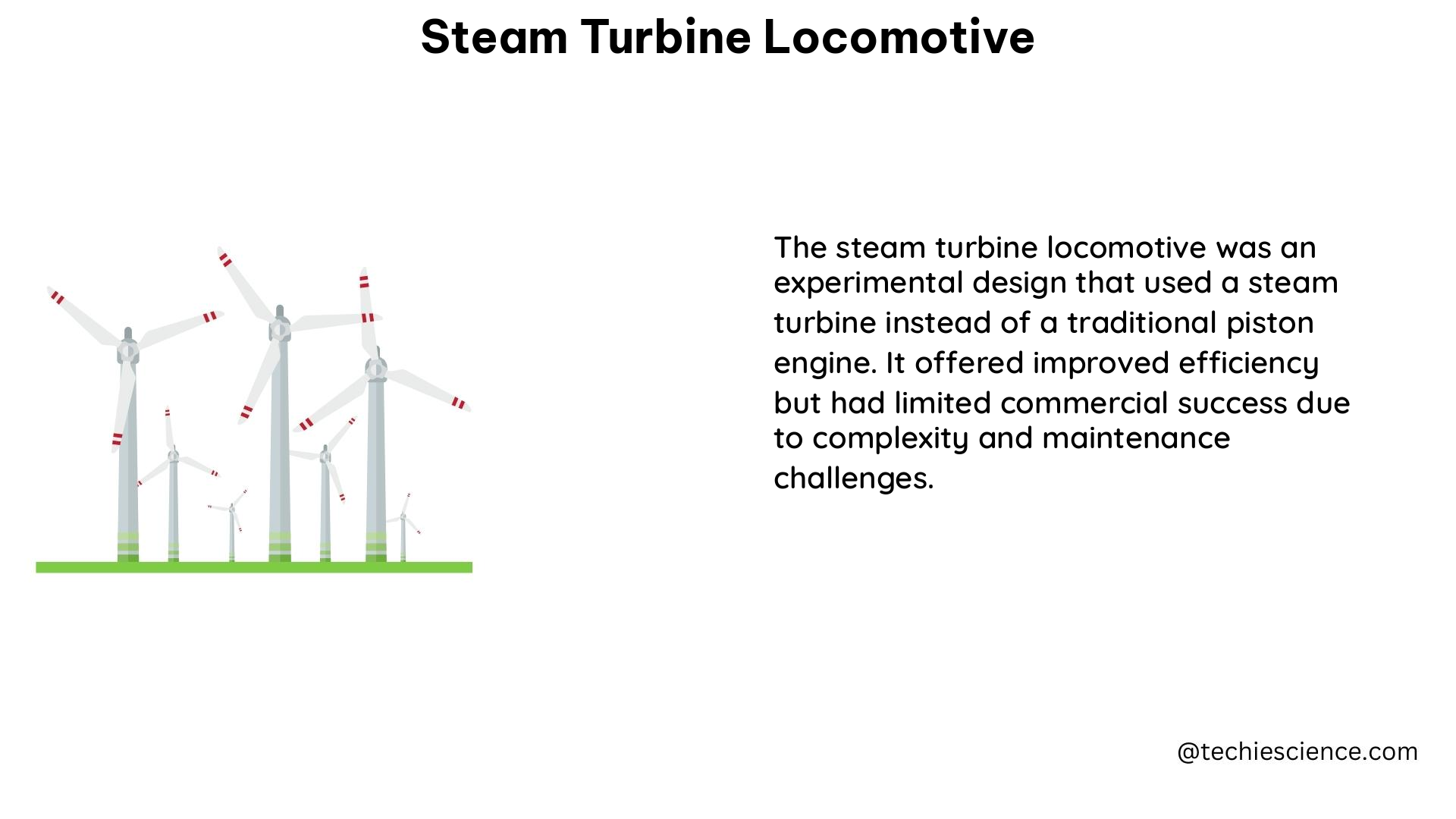Steam turbine locomotives are a remarkable feat of engineering, harnessing the power of steam to propel these massive machines across the rails. These locomotives utilize a steam turbine to convert the thermal energy of steam into mechanical energy, which then drives the wheels, enabling them to achieve impressive power outputs and speeds.
Power Output and Efficiency
At the heart of a steam turbine locomotive lies a powerful turbine capable of generating over 6,000 horsepower (hp). These locomotives operate at high steam pressures, typically ranging from 600 to 1,000 pounds per square inch gauge (psig), and temperatures between 800 and 1,000 degrees Fahrenheit. This combination of high pressure and temperature allows steam turbine locomotives to achieve thermal efficiencies of up to 12-15%, significantly higher than traditional steam locomotives that use piston engines, which typically have efficiencies around 8-10%.
Dimensional Specifications

In terms of size and weight, steam turbine locomotives are truly impressive. Some models can weigh over 1 million pounds, dwarfing their piston-powered counterparts. The sheer size of these locomotives is also evident, with some measuring over 100 feet in length. This massive scale is necessary to accommodate the complex turbine machinery and the large fuel and water storage requirements.
Speed and Fuel Consumption
The high-powered nature of steam turbine locomotives allows them to reach impressive speeds, with some models capable of reaching over 100 miles per hour. However, this performance comes at a cost, as these locomotives can consume vast amounts of fuel, with some models requiring over 10,000 gallons of fuel per day.
Technical Specifications
The steam turbine used in these locomotives is typically a reaction turbine, which utilizes the momentum of the steam to create rotational motion. The turbine is often multi-staged, with each stage consisting of a set of rotating blades and stationary nozzles. A governor regulates the steam flow to the turbine, adjusting it based on the locomotive’s speed.
To ensure proper operation, steam turbine locomotives require advanced lubrication and cooling systems. The lubrication system helps reduce friction and wear on the moving parts, while the cooling system removes heat from the turbine and other components to prevent overheating.
The exhaust system plays a crucial role in releasing the steam after it has passed through the turbine, and the control system regulates the overall operation of the turbine based on input from various sensors and other components.
DIY Steam Turbine Locomotive
Building a steam turbine locomotive from scratch is an immensely challenging task, requiring a deep understanding of mechanical engineering, metallurgy, and other related fields. However, for those with the necessary expertise and resources, the process can be a rewarding endeavor.
The key steps in building a DIY steam turbine locomotive include:
- Research: Thoroughly study the history and principles of steam turbine technology to gain a comprehensive understanding of the system.
- Design: Develop a detailed design for the locomotive, considering factors such as power output, steam pressure and temperature, and other relevant specifications.
- Materials Selection: Choose the appropriate materials, such as steel, brass, and copper, to construct the various components of the locomotive.
- Fabrication: Meticulously fabricate the turbine blades, nozzles, casing, and other critical parts using advanced manufacturing techniques.
- Assembly: Carefully assemble the locomotive, ensuring proper alignment and fit of all the components.
- Testing: Rigorously test the locomotive to ensure its safe and efficient operation, making any necessary adjustments or modifications.
Building a steam turbine locomotive from scratch is a true testament to human ingenuity and engineering prowess. While it is a complex and challenging undertaking, the rewards of witnessing the power and majesty of these machines in action are truly unparalleled.
References
- DS 13-3 Steam Turbines (Data Sheet) – FM Global
- Gross error detection in steam turbine measurements based on data reconciliation of inequality constraints – ScienceDirect
- Steam Turbine – an overview | ScienceDirect Topics
- Steam System Survey Guide – Department of Energy
- The units and measure of steam locomotive thermal efficiency – Trains.com

The lambdageeks.com Core SME Team is a group of experienced subject matter experts from diverse scientific and technical fields including Physics, Chemistry, Technology,Electronics & Electrical Engineering, Automotive, Mechanical Engineering. Our team collaborates to create high-quality, well-researched articles on a wide range of science and technology topics for the lambdageeks.com website.
All Our Senior SME are having more than 7 Years of experience in the respective fields . They are either Working Industry Professionals or assocaited With different Universities. Refer Our Authors Page to get to know About our Core SMEs.